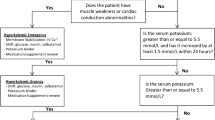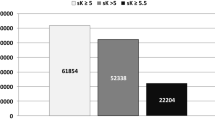Abstract
Introduction
Hyperkalemia, one of the most important electrolyte abnormalities of chronic kidney disease (CKD), often limits the use of renin–angiotensin–aldosterone system inhibitors and can increase in the postprandial period. In this study we report a real-world experience with the new non-adsorbed potassium binder patiromer in stage 3b-4 CKD patients. Moreover, we performed a cross-sectional analysis to evaluate, for the first time, the efficacy of patiromer in the control of postprandial potassium concentrations.
Methods
We retrospectively collected data of 40 patients at the time of patiromer initiation (T0), and after 2 (T2), 6 (T6) and 12 (T12) months of treatment. For cross sectional analysis, a blood sample was collected 2 h after the main meal for the evaluation of postprandial potassium concentrations.
Results
Eighty-two point five percent of patients (33/40) reached normal potassium concentrations at T2. Serum potassium significantly decreased at T2 compared to T0 (5.13 ± 0.48 vs 5.77 ± 0.41 mmol/L, respectively; p < 0.001) and the reduction remained significant during the follow-up (5.06 ± 0.36 at T6 and 5.77 ± 0.41 at T12; p < 0.001 vs T0). Renin–angiotensin–aldosterone system inhibitors were continued by 93% of patients (27/29). Adverse events were reported in 27.5% of patients and were all mild-to-moderate. Postprandial potassium concentrations did not significantly change compared to fasting state potassium measured at T12 (4.53 ± 0.33 vs 5.06 ± 0.36 mmol/L; p = 0.15).
Conclusions
In a real-world setting of advanced CKD patients, patiromer is a useful treatment for hyperkalemia, since it significantly reduces serum potassium levels over the long term and is able to maintain potassium concentrations in the normal range even in the post-prandial period.
Graphical abstract




Similar content being viewed by others
Data availability
All data are available upon reasonable request.
References
Einhorn LM, Zhan M, Hsu VD et al (2009) The frequency of hyperkalemia and its significance in chronic kidney disease. Arch Intern Med 169:1156–1162
Sarnowski A, Gama RM, Dawson A et al (2022) Hyperkalemia in chronic kidney disease: links, risks and management. Int J Nephrol Renovasc Dis 15:215–228
Clase CM, CarreroJJ EDH et al (2020) Potassium homeostasis and management of dyskalemia in kidney diseases: conclusions from a Kidney Disease: Improving Global Outcomes (KDIGO) controversies conference. Kid Kidney Int 97:42–61
Larivée NL, Michaud JB, More KM et al (2023) Hyperkalemia: prevalence. Predict Emerg Treat Cardiol Ther 12(1):35–63
Maschio G, Alberti D, Janin G et al (1996) The Angiotensin converting-enzyme inhibition in progressive renal insufficiency study group. Effect of the angiotensin-converting-enzyme inhibitor benazepril on the progression of chronic renal insufficiency. N Eng J Med 334:939–945
The GISEN Group (Gruppo Italiano di Studi Epidemiologici In Nefrologia) (1997) Randomised placebo-controlled trial of effect of ramipril on decline in glomerular filtration rate and risk of terminal renal failure in proteinuric, non-diabetic nephropathy. Lancet 349:1857–1863
Cheung AK, Chang TI, Cushman WC et al (2019) Blood pressure in chronic kidney disease: conclusions from a kidney disease: improving global outcomes (KDIGO) controversies conference. Kidney Int 95:1027–1036
Kidney Disease Improving Global Outcome (KDIGO) Working Group (2012) KDIGO clinical practice guideline for the management of blood pressure in chronic kidney disease. Kidney Int 2:337–414
Taler SJ, Agarwal R, Bakris GL et al (2013) KDOQI US commentary on the 2012 KDIGO clinical practice guideline for management of blood pressure in CKD. Am J Kidney Dis 62:201–213
Capuano I, Buonanno P, Riccio E et al (2022) Randomized controlled trials on renin angiotensin aldosterone system inhibitors in chronic kidney disease stages 3–5: are they robust? a fragility index analysis. J Clin Med 11(20):6184
Epstein M, Reaven NL, Funk SE et al (2015) Evaluation of the treatment gap between clinical guidelines and the utilization of renin-angiotensin-aldosterone system inhibitors. Am J Manag Care 21:S212-220
Yildirim T, Arici M, Piskinpasa S et al (2012) Major barriers against renin–angiotensin–aldosterone system blocker use in chronic kidney disease stages 3–5 in clinical practice: a safety concern? Ren Fail 34:1095–1099
McCullogh PA, Rangaswami J (2018) Real or perceived: hyperkalemia is a major deterrent for renin-angiotensin aldosterone system inhibition in heart failure. Nephron 138:173–175
Riccio E, Capuano I, Buonanno P et al (2022) RAAS inhibitor prescription and hyperkalemia event in patients with chronic kidney disease: a single-center retrospective study. Front Cardiovasc Med 9:824095
Palmer BF (2004) Managing hyperkalemia caused by inhibitors of the renin–angiotensin–aldosterone system. N Engl J Med 351:585–592
Sterns RH, Rojas M, Bernstein P, Chennupati S (2010) Ion-exchange resins for the treatment of hyperkalemia: are they safe and effective? J Am Soc Nephrol 21:733–735
Harel Z, Harel S, Shah PS et al (2013) Gastrointestinal adverse events with sodium polystyrene sulfonate (Kayexalate) use: a systematic review. Am J Med 126(3):264.e9-264.e24
Buysse JM, Huang IZ, Pitt B (2012) PEARL HF: prevention of hyperkalemia in patients with heart failure using a novel polymeric potassium binder, RLY5016. Futur Cardiol 8:17–28
Agarwal R, Rossignol P, Romero A (2019) Patiromer versus placebo to enable spironolactone use in patients with resistant hypertension and chronic kidney disease (AMBER): a phase 2, randomised, double-blind, placebo-controlled trial. Lancet 394(10208):1540–1550
St-Jules DE, Fouque D (2022) Etiology-based dietary approach for managing hyperkalemia in people with chronic kidney disease. Nutr Rev 80(11):2198–2205
Hinderling PH (2016) The pharmacokinetics of potassium in humans is unusual. J Clin Pharmacol 56(10):1212–1220
Kovesdy CP, Gosmanova EO, Woods SD et al (2020) Real-world management of hyperkalemia with patiromer among United States Veterans. Postgrad Med 132(2):176–183
Pecoits-Filho R, McCullough K, Muenz D et al (2022) Patiromer utilization in patients with advanced chronic kidney disease under nephrology care in Germany. Clin Kidney J 16(1):176–183
Levey AS, Stevens LA, Schmid CH et al (2009) A new equation to estimate glomerular filtration rate. Ann Intern Med 150:604–612
Bakris GL, Pitt B, Weir MR et al (2015) Effect of patiromer on serum potassium level in patients with hyperkalemia and diabetic kidney disease: the AMETHYST-DN randomized clinical trial AMETHYST-DN. Invest JAMA 314(2):151–161
Weir MR, Bakris GL, Bushinsky DA, OPAL-HK Investigators et al (2015) Investigators patiromer in patients with kidney disease and hyperkalemia receiving RAAS inhibitors. N Engl J Med 372(3):211–221
Pitt B, Bakris GL, Bushinsky DA et al (2015) Effect of patiromer on reducing serum potassium and preventing recurrent hyperkalaemia in patients with heart failure and chronic kidney disease on RAAS inhibitors. Eur J Heart Fail 17:1057–1065
Pitt B, Bakris GL, Weir MR et al (2018) Long-term effects of patiromer for hyperkalaemia treatment in patients with mild heart failure and diabetic nephropathy on angiotensin-converting enzymes/angiotensin receptor blockers: results from AMETHYST-DN. ESC Heart Fail 5:592
Drieling RL, LaCroix AZ, Beresford SA et al (2016) Validity of self-reported medication use compared with pharmacy records in a cohort of older women: findings from the women’s health initiative. Am J Epidemiol 184:233–238
Pecoits-Filho R, Fliser D, Tu C et al (2019) Prescription of renin-angiotensin-aldosterone system inhibitors (RAASi) and its determinants in patients with advanced CKD under nephrologist care. J Clin Hypertens (Greenwich) 21:991–1001
Sabbatini M, Garofalo G, Borrelli S et al (2014) Efficacy of a reduced pill burden on therapeutic adherence to calcineurin inhibitors in renal transplant recipients: an observational study. Patient Prefer Adherence 8:73–81
te Dorsthorst RPM, Hendrikse J, Vervoorn MT et al (2019) Review of case reports on hyperkalemia induced by dietary intake: not restricted to chronic kidney disease patients. Eur J Clin Nutr 73(1):38–45
Ramos CI, González-Ortiz A, Espinosa-Cuevas A et al (2021) Does dietary potassium intake associate with hyperkalemia in patients with chronic kidney disease? Nephrol Dial Transplant 36(11):2049–2057
Funding
The authors received no financial support for the research, authorship, and/or publication of this article.
Author information
Authors and Affiliations
Contributions
AP had the original idea; AP, ADE, AS, ODM, IC, MA, MR followed the patients; PB performed the statistical analysis; ER wrote the paper; all authors revised the paper and approved the final version.
Corresponding author
Ethics declarations
Conflict of interest
Authors declare that no conflict of interest exists.
Ethical approval
All procedures performed were in accordance with the ethical standards of the institute and regional research committee and with the 1964 Helsinki declaration and its later amendments of comparable ethical standards.
Human and animal rights
This article does not contain any studies with human participants or animals performed by any of the authors.
Informed consent
All participants signed written informed consent for participation in the study.
Additional information
Publisher's Note
Springer Nature remains neutral with regard to jurisdictional claims in published maps and institutional affiliations.
Rights and permissions
Springer Nature or its licensor (e.g. a society or other partner) holds exclusive rights to this article under a publishing agreement with the author(s) or other rightsholder(s); author self-archiving of the accepted manuscript version of this article is solely governed by the terms of such publishing agreement and applicable law.
About this article
Cite this article
Riccio, E., D’Ercole, A., Sannino, A. et al. Real-world management of chronic and postprandial hyperkalemia in CKD patients treated with patiromer: a single-center retrospective study. J Nephrol (2024). https://doi.org/10.1007/s40620-024-01897-9
Received:
Accepted:
Published:
DOI: https://doi.org/10.1007/s40620-024-01897-9




